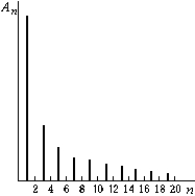Multiple Choice
 An examination of this frequency spectrum allows you to conclude that
An examination of this frequency spectrum allows you to conclude that
A) the odd harmonics 1 through 19 are present in the composite wave.
B) the even harmonics 2 through 20 are present in the composite wave.
C) the amplitudes of the component waves are equal.
D) the wave form is a simple sinusoid.
E) None of these is correct.
Correct Answer:

Verified
Correct Answer:
Verified
Q16: The standing waves in air in
Q26: The reason we can tell the difference
Q43: <img src="https://d2lvgg3v3hfg70.cloudfront.net/TB6080/.jpg" alt=" In graph A,
Q45: <img src="https://d2lvgg3v3hfg70.cloudfront.net/TB6080/.jpg" alt=" At P<sub>2</sub> the
Q46: <img src="https://d2lvgg3v3hfg70.cloudfront.net/TB6080/.jpg" alt=" A stretched string
Q48: <img src="https://d2lvgg3v3hfg70.cloudfront.net/TB6080/.jpg" alt="
Q48: A string with mass density equal to
Q49: If both the tension and the length
Q50: A standing wave is created by oscillating
Q52: <img src="https://d2lvgg3v3hfg70.cloudfront.net/TB6080/.jpg" alt=" The figure shows